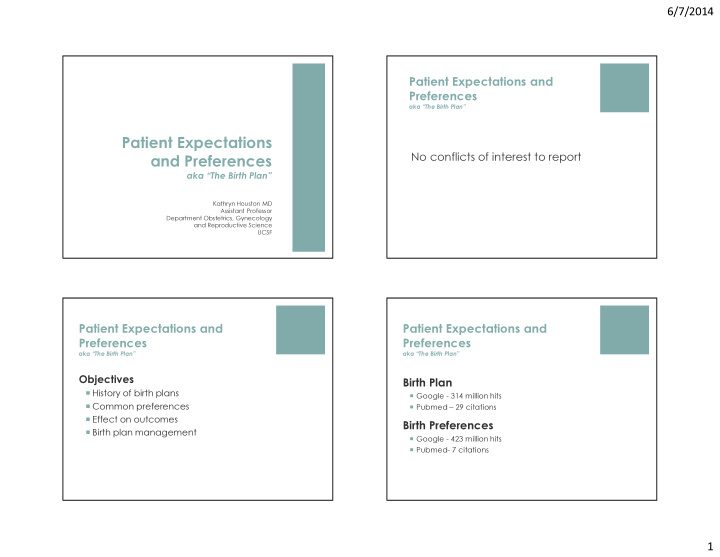



6/7/2014 Patient Expectations and Preferences aka “The Birth Plan” Patient Expectations No conflicts of interest to report and Preferences aka “The Birth Plan” Kathryn Houston MD Assistant Professor Department Obstetrics, Gynecology and Reproductive Science UCSF Patient Expectations and Patient Expectations and Preferences Preferences aka “The Birth Plan” aka “The Birth Plan” Objectives Birth Plan � History of birth plans � Google - 314 million hits � Common preferences � Pubmed – 29 citations � Effect on outcomes Birth Preferences � Birth plan management � Google - 423 million hits � Pubmed- 7 citations 1
6/7/2014 Birth Expectations and History of the Birth Plan Preferences Origins Labor/Birth Education Cultural, geographic and institutional Preferences/ Experience Mode of Birth Plan differences Delivery Patient Char. United States Patient Satisfaction History of the Birth Plan History of the Birth Plan Origins Cultural, geographic and institutional � UK 1970s differences � Childbirth educators � Demographics � “Planning your Baby’s Birth” � P0, white, older, higher education/SES, CNM � WHO 1996 care � Useful and should be preformed � Availability of education resources � 21 st century � Availability of birth options � Non-intervention vs intervention Simkin 1980, World Health Organization 1996 Bailey 2008, Hidalgo-Lopezosa 2013, Jones 2009, Miller 2012, Pennell 2011 2
6/7/2014 What is a Birth Plan? History of the Birth Plan “A birth plan is an approach to labor, rather than a term for a specific kind of outcome” United States � Childbirth education � ACOG & AA pediatrics � Written or philosophical � Cochrane Review � Evolves from patients values, desires and concerns of the � Healthy People 2010 goal birth process � Increase participation in childbirth classes � Facilitates communication between patient and provider � Practice models � Discussion Birth Plan vs. Hospital Birth Plan � More physician/hospital based American Academy of Pediatrics-The American College of Obstetricians and Wagner & Gunning 2006, Kaufman 2007 Gynecologists 2007, Gagnon 2007, Healthy People 2010 Common Birth Plan Themes Common Birth Plan Themes Logistics Domains � CONTROL � Venue � Pain control � Autonomy � Respect � Provider � Mode of delivery � Safety � Knowledge � Interventions � Infant care � Shared decision making 3
6/7/2014 Do preferences affect Do preferences affect outcomes? outcomes? Provider and patient perceptions Provider and patient perceptions � Wide variation Preferences vs. written birth plan � Worse outcomes - 65% vs 2.4% � Increased CS rates – 66% vs 9% Expectations � False sense of control � Professional pressure Grant 2010, Lundgren 2003, Welsh 2013 Do preferences affect Do preferences affect outcomes? outcomes? Maternal Neonatal Preferences vs. written birth plan � APGARS � Labor interventions � Mixed results � Cord gases � Pain control � No RCTs � Mode of delivery � Useful vs no difference � Intapartum care, control � More critical of provider Brown 1998, Kuo 2010 Lundgren 2003, Sato 2011, Whitford 1998 4
6/7/2014 Do preferences affect Do preferences affect outcomes? outcomes? Maternal Maternal � Labor Interventions � Mode of delivery � Pitocin � Vaginal Delivery � Episiotomies � Strength of preference � Pain Control � Cesarean Section � 67% no meds, 50% no epidural planned � 1/3 used no meds, 1/2 no epidural � 90% satisfied with epidural Casas 2009, Deering 2007, Hilgado-Lopezosa 2013, Pennell 2011 Fuglenes 2012, Hadar 2012, Wu 2014 Do preferences affect Do preferences affect outcomes? outcomes? Postpartum Neonatal � APGARS � Patient satisfaction � Cord gases � Goal vs. Journey � Medicolegal aspects Hilgado-Lopezosa 2013 5
6/7/2014 Do preferences affect Do preferences affect outcomes? outcomes? Postpartum Postpartum � Patient satisfaction � Goal vs. Journey � Personal Expectations � Healthy Mom & Baby � Provider support � “The perfect birth” � Provider-patient relationship � Long term effects � Involvement in decision making � Depression & mode of delivery Hodnett 2002 Rauh 2012, Sword 2011, Uplong 2006 Do preferences affect outcomes? Managing the birth plan Advantages/disadvantages Postpartum � Patient care/satisfaction � Medicolegal aspects � Lots of TIME � Living will for obstetrics � Provides structured discussion Provider vs. patient perspective � Reduce conflict/misunderstandings � Distrust vs. collaboration � Address risk � Evidenced based practice � Documentation Institutional constraints � May reduce litigation � Hospital policy vs. hospital routine Philepsen 2005, Richards 1999 Epstein 2004 6
6/7/2014 Birth Expectations and Managing the birth plan Preferences Optimizing use Setting expectations Labor/Birth Education � Review in outpatient � Avoids misunderstandings setting on L&D Preferences/ Experience Mode of Birth Plan � 1 page, unique wishes, � Improves satisfaction Delivery flexible � Lack of control Patient Char. Education Documentation � Listen, teach, build trust/partnership � Shared decision making Patient Satisfaction Conclusions Preferences matter � Embrace the birth plan Clinical outcomes � Some influence Integration into practice � Prenatal discussion 7
Recommend
More recommend